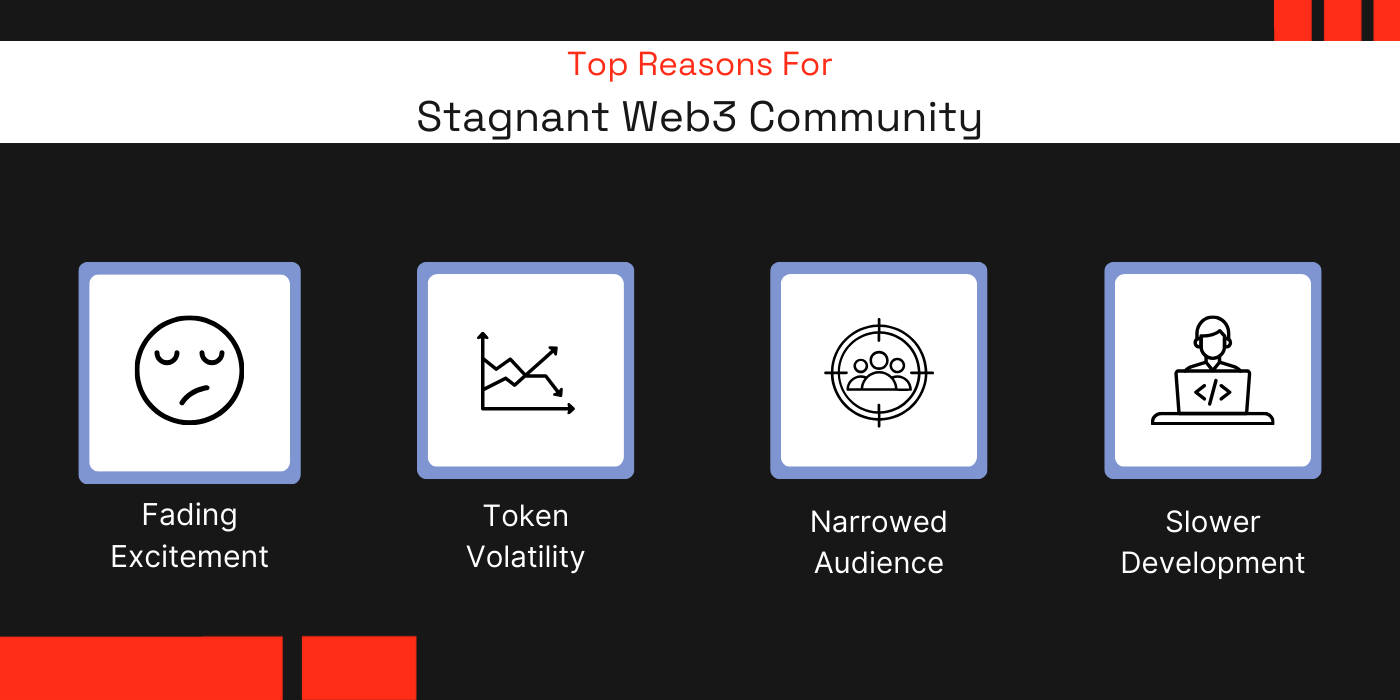Get insights.
Unlock value.
- 14-day free trial
- Set up in minutes
- No credit card required
How to Address Stagnant Growth In Your Web3 Community Through Token-Gated Surveys?
Are you a Web3 community manager? Do you know, a stagnant Web3 community can do much harm? It steals the motivation of members who contribute to the community. It causes decreased adoption of your Web3 project & related technologies. Finally, the long term sustainability of your Web3 community becomes a question mark.
Let’s find out why most Web3 communities are stagnant in growth.
Reasons For Stagnant Web3 Community
Below are 4 clear reasons for the Stagnant growth of the Web3 community.

- Fading Excitement: The Web3 community is usually started with hype and excitement. As time progresses, the initial excitement fades. Both the community manager and the members lose interest in further progress.
- Token Volatility: Every Web3 project contains a native token. When the value of the native token comes down due to market fluctuations, collaboration stops. Members who have joined only for monetary benefits eventually leave the community.
- Narrowed Audience: Web3 and decentralized technologies are new, evolving and niche. Web3 does not have a large audience. It has only narrowed limited members, which reflects limited community engagement.
- Slower Development: Web3 technologies are complex and are not easy to develop. This is a new space, and the available knowledge is limited. This results in slower development of applications, resulting in stagnant community growth.
Token-Gated Survey is a solution to this stagnant growth of the Web3 community. Let’s see how a gated survey can address the problem of stagnant growth.
Fueling Web3 Community With Token-Gated Surveys
Token-Gated Surveys fuels Web3 community growth.
Token-Gated surveys allow you to restrict the audience who can take your surveys. Respondents can take the surveys only when they have required token holdings in their wallet.
Below are the ways in which Token-Gated Surveys can address stagnant growth in the Web3 community.
- Meaningful Conversations: With Token-gated surveys you are actually reaching an invested and targeted audience who are genuinely interested individuals of your Web3 community. This in-turn triggers meaningful interactions within the community, driving growth.
- Genuine Responses: Gated surveys filter out spam responses in your survey. This is because only genuine and invested respondents take your survey. Ultimately, you receive accurate responses that guide the community towards positivity.
- Sense of Exclusivity: Participants of gated surveys feel special about the exclusivity it provides. People tend to experience the “Fear of missing out” emotion, thus speeding up their willingness to take the survey and contribute to the community.
- Promising Governance: Gated surveys are seen as a promising tool to grant voting rights to your community respondents. These voting rights are provided only to the targeted, invested and genuine participants, amounting to improved community governance.
- Incentivizing Culture: Crypto Wallet address is collected by default while running gated surveys. The availability of wallet addresses provides an easy means to reward FTs & NFTs to the community members. It’s also a great way to reward while maintaining the anonymity of the recipient.
Finally, it is also essential to analyze the survey results and craft clear segmentation strategies for continuous improvement. This helps you stay ahead of stagnation and be optimized for the future of your Web3 community.
How to use BlockSurvey For Token-Gated Survey?
BlockSurvey comes with a built-in Token Gated Survey feature. This feature is highly customizable and helps you thwart growth stagnation in your Web3 community.
Sign up for BlockSurvey & follow the below 5 steps to create a Token-Gated Survey with BlockSurvey.
- Choose your network: Start by choosing your network. While writing this blog, BlockSurvey supports token gating for Bitcoin, Stacks, Solana, Ethereum, Polygon, Avalanche, BNB, Celo & Gnosis. More networks are expected in the future.
- Set up Token Gating: Follow by choosing the Token name you want to use. It is possible to set up multiple token gating conditions. For projects that are not in the list, select the other option to mention specifications.
- Design your survey: Now it's time to design your survey questions. BlockSurvey offers a wide range of question types & customization options to help you align your survey with your goals. Be sure to try BlockSurvey’s anonymous badge feature.
- Publish your survey: Once you have designed your survey, click the publish button, to make your survey live.
- Test your Token-gating: Open up the survey URL, and perform a test submission from your wallet. When everything works fine, you can share it with your respondents. You can share the URL of your survey to your respondents from the share screen.
How BlockSurvey’s customers benefited?
Yuga Labs
Jeff Nicholas (Creative Director at Yuga Labs) is one of BlockSurvey’s happy customers. Jeff’s primary challenge was the inability to collect responses securely and effectively. Yuga Labs wanted their Token holders to provide feedback without compromising personal information.
BlockSurvey’s ability to seamlessly integrate Token-Gating & delegate Wallet support was a game changer for Yuga Labs.
Smartists
Georgina (Published Author) from Spain benefited from BlockSurvey’s solution as she ventured into collaborative projects with an Artist Studio. Adding BlockSurvey’s Token-Gating feature allowed her to offer exclusive access to licensed content for specific clients and NFT collectors.
Georgina is more satisfied with managing intellectual property through Token-Gating Surveys.
Today the Game
David is the head of growth at ‘Today the Game’. David faced unique challenges in gathering detailed information from the fans & followers.BlockSurvey tailored a tool specifically for their requirements. This included address-linked questions and allow-list response gating.
It improved community relations and also provided a solid foundation for future engagements.
Conclusion
Token-Gated Surveys are powerful tools to ignite excitement in your Web3 community. By overcoming stagnation, Token-gated survey is the perfect tool for growing the communities of ever evolving Web3 ecosystem.
To thwart the pains of your Web3 community, start using your Web3-Friendly BlockSurvey now.
How to Address Stagnant Growth In Your Web3 Community Through Token-Gated Surveys? FAQ
What causes stagnant growth in Web3 communities?
Stagnant growth in Web3 communities can be attributed to several factors, including the fading of initial excitement, token volatility, a niche audience, and the slower development of Web3 technologies.
How can Token-Gated surveys help improve the growth of a Web3 community?
Token-Gated Surveys target a specific, invested audience, leading to meaningful interactions and high-quality responses. They also create a sense of exclusivity, improve governance, and incentivize participation, all of which contribute to combating stagnation and promoting growth.
What is the difference between a regular survey and a Token-Gated Survey?
A regular survey is open to anyone, while a Token-Gated Survey restricts participation to individuals who hold specific tokens in their crypto wallets, ensuring that only genuinely interested and invested community members contribute.
How can I set up a Token-Gated Survey using BlockSurvey?
To set up a Token-Gated Survey with BlockSurvey, you need to choose your network, set up token gating by selecting the relevant token, design your survey, publish it, and then test the Token-Gating to ensure everything works before sharing it with respondents.
Get insights.
Unlock value.
- 14-day free trial
- Set up in minutes
- No credit card required




